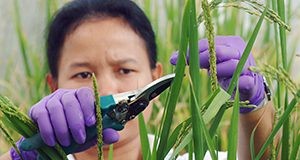Abstract
Rice production in the Everglades Agriculture Area (EAA) of Florida dates back nearly seven decades. For a brief period in the 1950s about 2,000 acres of rice was grown in the EAA. Rice was reintroduced in the EAA in 1977 after it was demonstrated that rice could be successfully incorporated into the sugarcane production cycle during the fallow period. This 3-page fact sheet provides a history of rice production in Florida and information about rice varieties grown in Florida. Written by Jehangir H. Bhadha, Luigi Trotta, and Matthew VanWeelden, and published by the Soil and Water Sciences Department, May 2016.
References
Bhadha J., R. Khatiwada, S. Galindo, N, Xu, and J. Capasso. 2018. "Evidence of soil health benefits of flooded rice compared to fallow practice." Sustainable Agriculture Research. 7: 31-41. https://doi.org/10.5539/sar.v7n4p31
Cherry R., M. Tootoonchi, J.H. Bhadha , T.A. Lang, M. Krounos, and S. Daroub. 2015. "Effect of flood depth on rice water weevil (Coleoptera Curculionidae) populations in Florida rice fields." Journal of Entomological Science. 50: 311-317. https://doi.org/10.18474/JES15-05.1
Saichuk J., S. Brown, B. Courville, D. Groth, D. Harrell, C. Hollier, S. Linscombe, J. Oard, M. Stout , E. Webster, L. White, and R. Zaunbercher. 2015. Rice varieties and management tips. LSU Ag Center, Publication 2270.
Schueneman T., C. Rainbolt, and R. Gilbert. 2008. Rice in the crop rotation. SS-AGR-23. Gainesville: University of Florida Institute of Food and Agricultural Sciences. http://edis.ifas.ufl.edu/pi207
Wright, A.L. and G.H. Snyder G.H. 2009. Soil subsidence in the Everglades Agricultural Area. SL311. Gainesville: University of Florida Institute of Food and Agricultural Sciences. http://edis.ifas.ufl.edu/ss523

